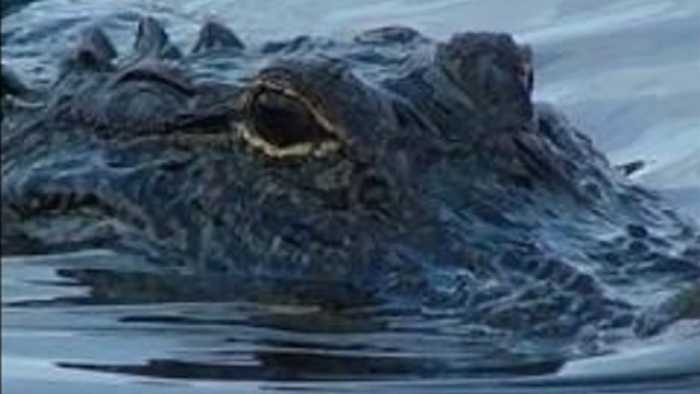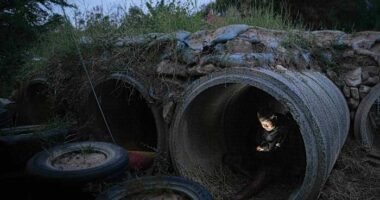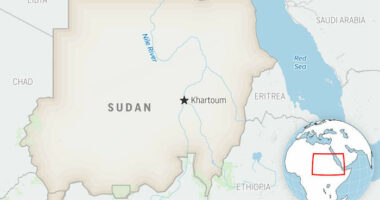Share this @internewscast.com

LA PAZ – It was after their tiny plane crashed into the Bolivian jungle earlier this week that their ordeal really began.
The plane crashed violently, overturning into a lagoon teeming with alligators and anacondas. This terrifying scenario unfolded into a 36-hour ordeal for the pilot and four passengers, including a 6-year-old boy, as they held onto the wreckage until they were rescued on Friday in the northeast of this Andean territory.
A doctor who attended to the five survivors reported to The Associated Press on Saturday that each was alert and stable. The sole patient still hospitalized was the young boy’s 37-year-old aunt due to a head wound infection. The others had been released and were recuperating from dehydration, minor chemical burns, along with cuts, bruises, and insect bites covering their bodies.
“It was astonishing that they remained unharmed by the wildlife and survived,” remarked Dr. Luis Soruco, the director at the hospital where the survivors were taken in Bolivia’s tropical Beni province. He spoke via phone after discharging the pilot and two women who were sent home with a potent antibiotic treatment.
The pilot, 27-year-old Pablo Andrés Velarde, emerged Friday to tell the story that has transfixed many Bolivians — a rare piece of uplifting news for a nation badly in need of it after years of a spiraling economic and political crisis.
“The mosquitoes wouldn’t let us sleep,” Velarde told reporters from his hospital cot in the provincial capital of Trinidad, where Dr. Soruco said he was in surprisingly good health and spirits. “The alligators and snakes watched us all night, but they didn’t come close.”
Shocked that the caimans (pronounced KAY-men), a species of the alligator family native to Central and South America, didn’t lunge at them, Velarde speculated it was the stench of jet fuel spilling from the wreckage that had kept the predatory reptiles at bay, although there’s no scientific proof that’s an effective alligator repellent.
Velarde said that the five of them survived by eating ground cassava flour that one of the women had brought as a snack. They had nothing to drink — the lagoon water was filled with gasoline.
The small plane had set off Wednesday from the Bolivian village of Baures, bound for the bigger town of Trinidad farther south, where Patricia Coria Guary had a medical check-up scheduled for her 6-year-old nephew at the pediatric hospital, Dr. Soruco said. Two other women, neighbors from Baures ages 32 and 54, joined them.
Such flights are a common form of transportation in this remote Amazonian region carved with rivers. Heavy rains wash away unpaved roads this time of year.
But just 27 minutes — almost halfway — into the flight, the plane’s lone engine cut out. Velarde said he reported their imminent crash over a portable radio to a colleague.
He recalled in interviews with local media that he scanned the vast emerald green canopy below him and aimed for a clearing near a lagoon.
“There was no ranch or road along the route,” he said. “It was just swamp.”
Instead of skidding across the shore as planned, the plane smashed into the ground and flipped upside down — injuring everyone on board and leaving Coria Guary with an especially deep cut to her forehead — before splashing into the water.
“The landing was very rough,” Velarde said.
As the plane flooded, the five of them managed to clamber on top of the fuselage, where they stayed for two terrifying nights surrounded by caimans and anacondas and attacked by swarms of mosquitoes and other insects.
They waved shirts and sheets to no avail and screamed each time they heard the thud of propellers or revving of a boat engine. On Friday, at the sound of approaching motorboats, “we started shining our cell phone flashlights and shouting,” Velarde said.
A group of fishermen noticed, and helped them into their canoe. They called the authorities and delivered them to an army helicopter some hours later.
“We couldn’t have handled it one more night,” Velarde said.
___
DeBre reported from Buenos Aires, Argentina.
Copyright 2025 The Associated Press. All rights reserved. This material may not be published, broadcast, rewritten or redistributed without permission.











